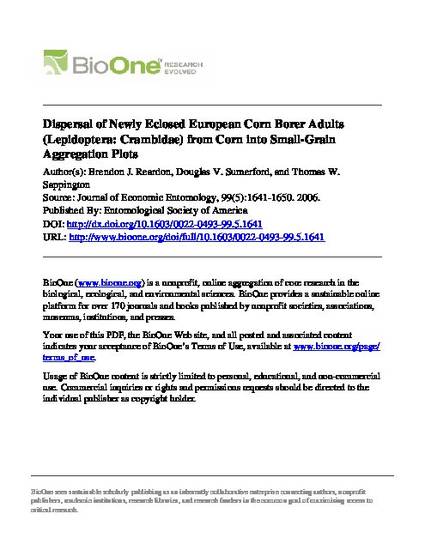
Genetically modified, insecticidal Bacillus thuringiensis (Bt) corn, Zea mays L., hybrids are used throughout the Corn Belt for European corn borer, Ostrinia nubilalis (Hübner) (Lepidoptera: Crambidae), control. To slow development of Bt corn resistance, the Environmental Protection Agency requires growers to plant a refuge. Determining the appropriate distance between a refuge and Bt corn, and development of mitigation–remediation strategies such as mass releases of susceptible moths, requires an understanding of adult dispersal and mating behavior. However, much remains unknown about these behaviors. Because mating often occurs in grass near cornfields where adult O. nubilalis aggregate, we planted small-grain plots as aggregation sites in an attempt to retain mass-released adults. The objectives of this study were to examine influences of pheromone lure, plant density, and plant species on distributions of feral and newly emerged, laboratory-reared O. nubilalis among small-grain aggregation plots. Feral adults were collected in aggregation plots in relative abundance, indicating that small-grain plots were acceptable aggregation sites. In contrast, newly emerged adults that were released weekly as dye-marked pupae were rarely found in aggregation plots, with ≈150–1,500-fold fewer adults captured than expected if all released adults had occupied the plots for ≥1 d. The majority of newly emerged adults did not colonize the aggregation plots, suggesting that recently eclosed adults leave their natal field and do not colonize the first aggregation sites encountered. Plant species significantly influenced adult distributions among aggregation plots. Mass releases of laboratory-reared pupae in the field may not be a viable remediation tactic because almost all of the newly emerged adults dispersed beyond 300 m of the release point.
Available at: http://works.bepress.com/thomas_sappington/35/

This article is from Journal of Economic Entomology 99 (2006): 1641, doi:10.1603/0022-0493-99.5.1641